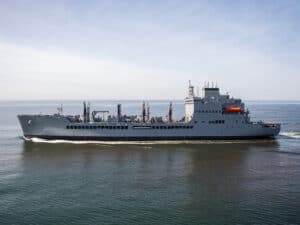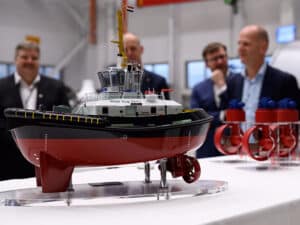
Crew costs on the increase
Written by Nick Blenkey SEPTEMBER 26, 2012 —International accountant and shipping consultant Moore Stephens says total annual operating costs in the shipping industry increased by an average 2.1 percent in 2011. This compares with a 2.2 percent average rise in costs the previous year. Crew costs were the main reason for the overall increase in 2011, while the cost of insurance fell for the second year in succession.
SEPTEMBER 26, 2012 —International accountant and shipping consultant Moore Stephens says total annual operating costs in the shipping industry increased by an average 2.1 percent in 2011. This compares with a 2.2 percent average rise in costs the previous year. Crew costs were the main reason for the overall increase in 2011, while the cost of insurance fell for the second year in succession.
The findings are set out in OpCost 2012, Moore Stephens’ annual ship operating costs report. The latest report, the twelfth year, includes data from more than 2,700 ships, a record number. Running cost information is obtained on a confidential basis from clients of Moore Stephens, and from other shipowners and ship managers who submit data for inclusion.
OpCost 2012 reveals that total operating costs for the three main tonnage sectors covered – bulkers, tankers and container ships – were all up in 2011, the financial year covered by the survey. Both the bulker and tanker indices increased by 3 index points (or 1.7 percent) on a year-on-year basis, while the container ship index (with a 2002 base year, as opposed to 2000 for the other two vessel classes) was up 5 index points, or 3.1 percent. The corresponding figures in last year’s OpCost report showed increases in the bulker, tanker and container ship indices of 5, 2 and 3 points respectively.
There was a 3.3 percent overall increase in 2011 crew costs compared to the 2010 figure. (By way of comparison, the 2008 report revealed a 21 percent increase in this category). Tankers, overall, experienced increases in crew costs of 2.2 percent on average, compared to 2.7 percent in 2010. Within the tanker sector, Suezmaxes reported an overall increase of 3.4 percent, while for operators of LPG carriers of between 3,000 and 8,000 cbm the crew bill was up by 6.7 percent. For bulkers, meanwhile, the overall increase in crew costs was 2.8 percent, compared to 4.0 percent the previous year, with the operators of Panamax bulkers paying 5.4 percent more than in 2010. For containerships, the increased spend on crew averaged 3.4 percent (as opposed to 2.9 percent in 2010), with smaller vessels (up to 1,000 TEU) paying 3.9 percent more than last year. Operators of larger dry cargo ships (above 25,000 dwt) and of smaller LPG carriers (between 3,000 and 8,000 cbm), however, experienced the biggest increase in crew expenditure – 6.7 percent in each case.
For repairs and maintenance, there was an overall fall in costs of 1.1 percent, compared to the 4.5 percent increase recorded for 2010. The only category of tonnage to show an increase here was containerships, where repairs and maintenance costs were up by 3.7 percent. There was no overall increase in these costs in the tanker sector, and a 1.9 percent fall in such expenditure for bulkers. Handysize and Handymax were the only bulker types to spend more on repairs and maintenance in 2011, and Handysize product tankers were alone among tankers in this respect. But in the containership sector the bigger vessels (between 2,000 and 6,000 TEU) spent 4.4 percent more on repairs and maintenance. Containerships up to 1,000 TEU, meanwhile, spent 3.2 percent more, and the increased repairs and maintenance expenditure for box ships between 1,000 and 2,000 teu was 1.5 percent.
OpCost 2012 revealed a 2.7 percent increase in the level of stores spending, after two successive years of declining expenditures. Some of the biggest increases here were in the tanker sector. Suezmaxes spent 5.5 percent more on stores than in the previous year, and Aframaxes 5.4 percent more. Panamaxes, where the stores spend was down by 2.4 percent, were the only category of tanker to show black ink. And there was no black ink at all for stores in the gas market, with operators of LPG carriers of between 70,000 and 85,000 cbm paying 6.5 percent more compared to 2010.
Expenditure on insurance dipped overall by 1.5 percent, this following a 4.7 percent fall in 2010. The insurance spend was down for bulkers and tankers overall by 4.5 and 3.4 percent respectively. Indeed, all categories of bulkers and tankers paid less for their insurance than they did in 2010. For container ships, though, it was more of a mixed picture. Whereas the larger box ships paid 0.7 percent less for their insurance in 2011, operators of smaller container ships paid 3.5 percent more.
Moore Stephens partner Richard Greiner says: “OpCost 2012 contains both good and bad news for the shipping industry. The bad news is that costs continue to rise. The good news is that costs are not rising as fast, or as steeply, as they were three or four years ago, and are in fact pretty much in line with predictions.
“Once again, it was an increase in crew costs which was the headline figure for the industry in 2011. The average overall increase in crew costs was in fact marginally down on the figure for 2010. This may be a reflection of the economic climate, and a consequence of more companies going out of business and more ships going into lay-up. But while crew costs remain the single biggest contributor to higher operating costs, they are still modest in comparison to some of the hefty increases posted in earlier years. Investing in good people is a must for the shipping industry, and will justify the price tag in the long term.
“There was a fall of just over one percent in repairs and maintenance expenditure, this despite continuing increases in the cost of labor and raw materials. Again, this may be a direct result of the economic downturn, which shipping has weathered better than many other industries. But nevertheless there has been reduced activity, a number of victims, and significant pressure on spending in many of those companies that have survived.
“Spending on stores was up in 2011. This is no surprise since the category includes the likes of lube oils, the price of which continued to rise throughout 2011 along with the price of crude oil. New technology in lube manufacture promises to make ships more environmentally friendly, and more efficient, but that will come at greater financial cost.
“Insurance costs were down again, which is not a surprise but an anomaly, given the economic climate and the pure underwriting figures for recent years. In a classic underwriting market undistorted by rampant competition, rates would be going up. As it is, with very few exceptions, they are going down. One of those exceptions can be found in the container ship sector, where a 3.5 percent increase in insurance costs for smaller box ships compares to an 0.7 percent fall in costs for the biggest vessels. This would suggest that the age of the ship remains a greater concern for underwriters than its size, which is nothing new.”





Leave a Reply
You must be logged in to post a comment.